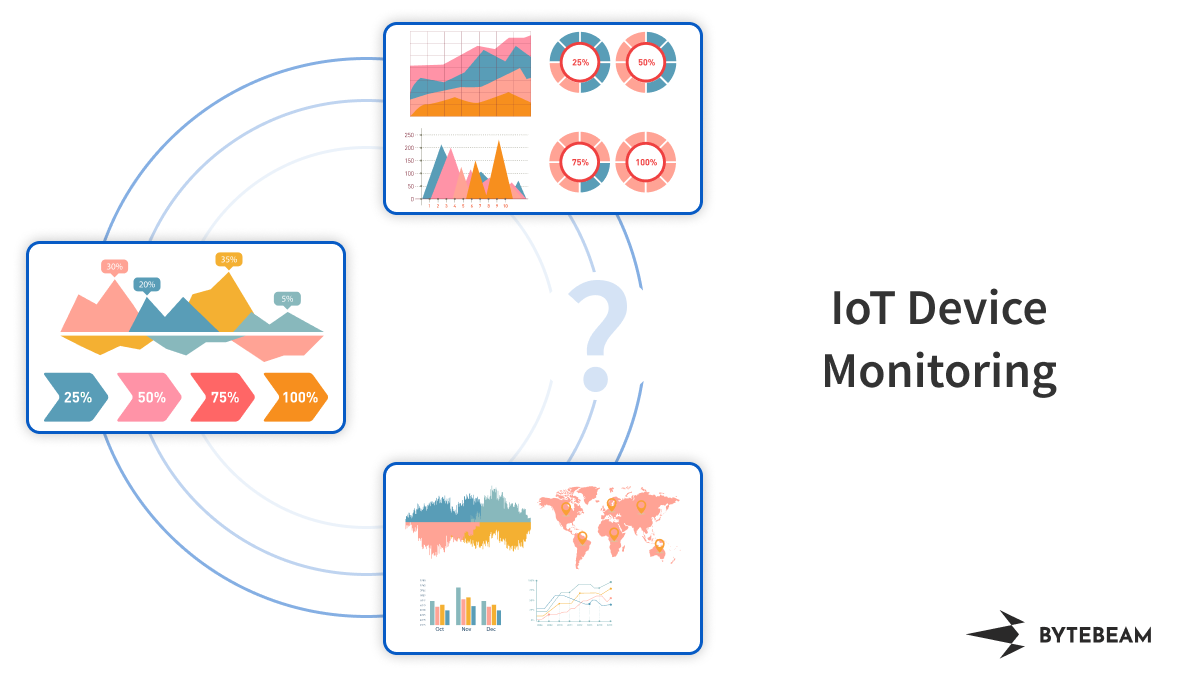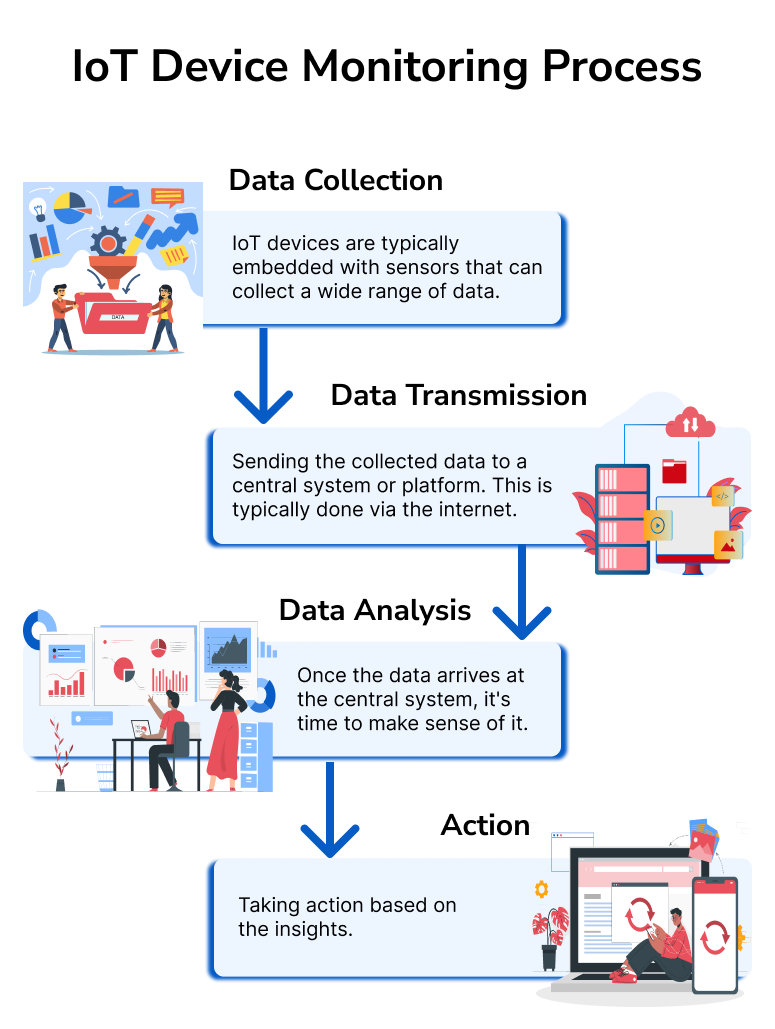IoT Device Monitoring: Choosing the Right Solution for Your Devices and Network

IoT device monitoring is one of the most important innovations of the last decade. While it is not exactly a new tech as the very first connected coffee pot was also monitored remotely, the applications of IoT device monitoring have only exploded in recent years.
With the rapid expansion of the Internet of Things (IoT) and countless devices connecting to networks, it's more important than ever to keep a close eye on the performance and security of your IoT devices.
What to expect: In this blog, we'll dive into the essentials of IoT device monitoring, discuss the benefits, and explore various monitoring techniques. We'll also offer expert advice on choosing the right IoT monitoring solution to fit your needs.
Understanding IoT Device Monitoring
Before we jump into the nitty-gritty, let's first establish a clear understanding of IoT device monitoring:
What is IoT device monitoring?
IoT device monitoring refers to the process of collecting, analyzing, and managing data from IoT devices to ensure optimal performance, security, and functionality. Monitoring IoT devices is an integral aspect of the IoT technology itself, as connected devices need to be monitored for them to perform optimally.
Think of device monitoring as a health checkup for your devices. It's a way to keep an eye on how your devices are performing and whether they're operating as expected. For example, a device might send information about its battery level, its temperature, or its operational status. This allows you to intervene and fix problems before they become more serious.
Let's say you have a smart refrigerator. This fridge can monitor its own temperature and alert you if it gets too warm. It can even track the freshness of your food items and let you know when something's about to go bad. This is a form of device monitoring.
But monitoring IoT devices is not only about the status of individual devices. It's also about how these devices interact with each other and with the network as a whole. For example, a device monitoring system could alert you if a device is using too much bandwidth, if it's not communicating with the network as often as it should, or if it's behaving in a way that suggests it's been compromised by a security threat.
To offer another quick example, an application of IoT device monitoring could be a farmer overlooking all the sensors in the field as they collect data.
Key components and architecture of IoT monitoring systems
IoT monitoring systems are foundationally no different from any other IoT architecture. This means that they all have device, connectivity, and cloud layers to various degrees depending on their complexity. A robust IoT monitoring platform will have the following components to ensure smooth operations:
- Devices: The sensors, actuators, and similar paraphernalia make up the devices. Naturally, the devices are a key component for monitoring. Enterprises can have thousands or even millions of devices on the field at any given time. The more complex a network of devices, the more important a sophisticated device monitoring platform becomes.
- Connectivity: The devices could be interconnected or directly connected to the server via Wi-Fi or GSM. This allows the device monitoring platform to monitor these devices remotely and cuts down on the need for physical intervention.
- Backend: The backend is often the platform layer of the cloud which processes and stores the data that is collected by the devices. This is the virtual ‘brains’ of the whole operation and allows us to make sense of a million data points that the devices collect.
- Dashboard: A robust IoT monitoring platform will come with a dashboard or a similar interface that makes it easy for users to access the device status and data collected.
- Analytics and Data Visualization: Accessing the data is not enough. Raw data is not useful for the average user. You need the data to make sense and you need data analytics and visualization capabilities for the same.
- Updates and alerts framework: Lastly, device monitoring isn’t enough if you aren’t alerted of issues in time and are unable to patch them through updates. Therefore, a good IoT platform will be able to provide you with an OTA updates framework along with alerting capabilities.
The importance of IoT device monitoring
The importance of monitoring IoT devices lies in its ability to maintain, manage, and optimize the performance of the ever-growing number of connected devices in today's networks. As the IoT landscape expands, effective device monitoring becomes increasingly essential for various reasons.
IoT may be an effective technology, but to leverage it, a business needs to invest a significant amount of time, money, and personnel. With this, comes the need to ensure that the investment pays off, and monitoring is absolutely crucial for that. It helps improve performance, enhances security, and supports the business in scaling the projects. IoT device monitoring is also key for improved user experience, which can be a big factor in the success of an undertaking. The ability to monitor and maintain device performance, security, and health not only improves the overall efficiency of IoT systems but also supports business growth and customer satisfaction.
Benefits of IoT Device Monitoring
Imagine running a large hotel with hundreds of rooms, and each room has a smart thermostat to control the room temperature. Now, if a few thermostats stop working or get stuck at a high temperature, it could lead to guest discomfort and, in the worst case, even ruin your hotel's reputation.
Now, if you have IoT monitoring tools, it's like having a dedicated person who constantly checks each thermostat's "health" and behavior. If one thermostat starts acting strangely, like not responding or showing incorrect temperature, this "person" (device monitoring system) would alert you immediately. You can then send a technician to fix it before the guest even notices. This ensures a smooth and comfortable stay for your guests, which can greatly enhance your hotel's reputation and profitability.
Without a IoT monitoring tools, you might not know about the thermostat problem until a guest complains, which could already damage your reputation.
IoT device monitoring brings a host of benefits to organizations and individuals alike. To understand them better, let’s look at them from our farmer’s perspective, from the earlier example:
Enhanced device performance and efficiency
By collecting real-time data, IoT monitoring tools helps identify bottlenecks and optimize device operation. Let’s call our farmer from the earlier example Sue. Now when Sue plants a particular crop, she notices that the yield is better on some occasions than others. To figure out the reason for this, Sue turns to her device monitoring platform. She quickly realizes that the moisture in the air affects her production and adjusts the water percentage accordingly. This helps Sue get a strong yield, year-round.
Improved security and privacy
Monitoring tools can detect potential security threats and vulnerabilities, enabling quick response and risk mitigation. IoT devices can present additional vulnerabilities as each device is an opportunity for malicious actors to gain access to the network. When one of the devices starts sending suspicious alerts, Sue quickly troubleshoots the device and realizes that its security has been compromised. This allows Sue to disconnect the device, scan it, reinstall it, and update all the devices to ensure that they are no longer vulnerable.
Proactive issue identification and resolution
With constant device monitoring, issues can be detected and resolved before they escalate, reducing downtime. When a corner of Sue’s field is not getting water, the IoT device monitoring platform alerts Sue that one of her sprinklers has a leakage that has blocked the supply to the corner. This allows Sue to quickly replace the faulty device and ensure that very little water is wasted and the entire field is well hydrated.
Cost savings and reduced downtime
Timely identification and resolution of issues minimize device downtime and associated costs. Because Sue’s farm is well-equipped and secure, Sue rarely has any big issues that would eat up her time, or cost her unexpected losses.
Scalability and future-proofing
A robust monitoring solution helps ensure your IoT infrastructure can scale with evolving technology and business needs. Sue is arguably more in touch with her farms than any other farmers who prefer traditional agricultural methods. This allows Sue to adjust her plans according to changes in market conditions or weather.
How to Monitor IoT Devices?
Before we can get into how IoT device monitoring works, we need to understand what exactly we are monitoring. Is it simply looking at various devices and whether they are working?
Well, no. There are several parameters that are considered when planning what to monitor on IoT devices.
Parameters for IoT device monitoring
When it comes to device monitoring in IoT, there are several important aspects that you might want to keep an eye on:
Device Status: This includes basic information like whether the device is on or off, and more complex statuses like what task the device is currently performing.
Operational Metrics: These are metrics related to the device's primary function. For example, if the device is a temperature sensor, you'd want to monitor the temperature it's reporting.
Resource Utilization: This could include metrics like CPU usage, memory usage, power consumption, and network bandwidth usage. If these metrics are too high, it could indicate a problem.
Connectivity Metrics: This could include things like signal strength, data transfer rates, and packet loss rates. Poor connectivity can seriously affect an IoT device's performance and reliability.
Device Health Metrics: These metrics can help predict when a device might fail. They might include things like battery level, temperature, and error rates.
Security Metrics: These could include indicators of potential cyber attacks, such as multiple failed login attempts, unexpected changes in device behavior, or suspicious network traffic patterns.
The specifics of what to monitor will vary greatly depending on the type of device and its role within your IoT system. It's important to focus on the metrics that are most relevant to your needs and goals.
It's also important to note that device monitoring is not just about collecting data. It's also about analyzing this data to extract useful insights and taking action based on these insights to maintain or improve the performance, efficiency, and security of your IoT devices.
How does IoT device monitoring work?
Device monitoring in the context of IoT works by using a combination of hardware (like sensors) and software (like cloud-based monitoring platforms) to continuously gather and analyze data from your devices. Here's a simplified explanation of how monitoring IoT devices work:

Data Collection: The first step is to collect data. IoT devices are typically embedded with sensors that can collect a wide range of data, such as temperature, pressure, humidity, light, sound, motion, and more. In addition to these physical parameters, IoT devices can also monitor digital parameters like device status (on/off), battery level, network connectivity, and data transmission rate.
Data Transmission: The next step is to send this data to a central system or platform. This is typically done via the internet, which is why we call it the Internet of Things. The devices can use various communication protocols (like Wi-Fi, Bluetooth, cellular networks, or even satellite communication in some cases) to send this data.
Data Analysis: Once the data arrives at the central system, it's time to make sense of it. This is where monitoring software comes into play. This software can analyze the data and provide valuable insights. For example, it might alert you if a device's battery is running low, if a device is overheating, or if a device hasn't sent any data for a long time.
Action: The final step is to take action based on these insights. For example, if you receive an alert that a device is overheating, you might send a technician to fix the problem. Or if a device's battery is running low, you might remotely put it into a power-saving mode until it can be recharged.
So, in a nutshell, device monitoring works by constantly collecting data from your devices, analyzing this data to extract meaningful insights, and then helping you take action to maintain the health and performance of your devices.
Things to Consider When Choosing an IoT Device Monitoring Solution
As you evaluate IoT monitoring solutions, keep these factors in mind to make an informed decision:
- Compatibility with existing IoT infrastructure: Ensure the IoT monitoring platform works seamlessly with your current devices and network.
- Scalability and adaptability: Choose a solution that can grow with your IoT network and adapt to new devices and technologies.
- Security and compliance features: Look for robust security features and compliance with relevant industry standards.
- Ease of deployment and integration: A user-friendly solution will make it easier to deploy and integrate with your existing infrastructure.
- User-friendly interface and reporting capabilities: An intuitive interface and comprehensive reporting features will help you make data-driven decisions.
- Support and maintenance services: Opt for a solution with reliable support services and regular maintenance to keep your monitoring system up-to-date.
- Budget and cost-effectiveness: Evaluate the costs associated with the solution and its potential return on investment.
Conclusion
Selecting the right IoT device monitoring solution is crucial for maintaining an efficient, secure, and successful IoT network. By understanding the basics of IoT monitoring, evaluating the benefits, and considering various monitoring techniques, you can make a well-informed decision to optimize your IoT infrastructure.
To make the most of your IoT device monitoring, keep the following points in mind:
- Regularly reassess your IoT infrastructure to ensure your monitoring solution remains compatible and effective as your network evolves.
- Stay informed about emerging IoT technologies and trends to future-proof your monitoring system and stay ahead of the curve.
- Encourage a culture of data-driven decision-making by utilizing the insights provided by your monitoring solution to improve device performance, security, and efficiency.
By implementing a comprehensive IoT device monitoring strategy, you'll be well-equipped to tackle any challenges that arise, ensuring the success of your IoT initiatives. A well-rounded IoT device monitoring solution such as Bytebeam can help you confidently capitalize on the incredible potential of the Internet of Things.
To know more about what we offer, feel free to get in touch with us.
We try to simplify IoT concepts in our blog every week. if you would like to learn more, subscribe to our blog and get a notification every time we publish!

